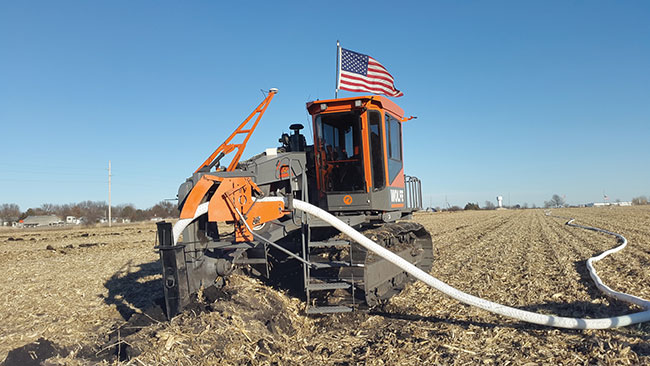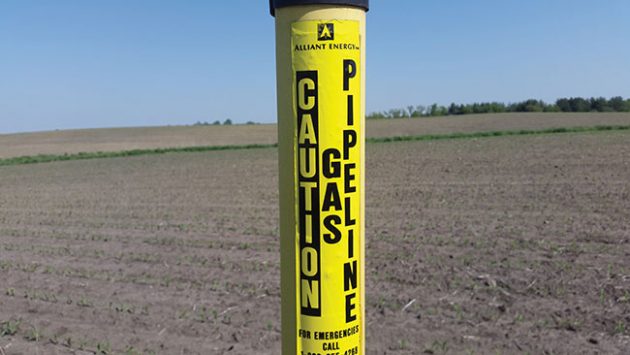
Features
Contractor at Work
Plan ahead: Safe installation of subsurface drainage systems
Planning for a safe installation of subsurface drainage systems.
June 29, 2020 By Kapil Arora
 Safely installing drain lines by plowing or trenching begins by contacting 811 when planning and designing the subsurface drainage system. Photos courtesy of Iowa State University – Agricultural and Natural Resources Extension Programs.
Safely installing drain lines by plowing or trenching begins by contacting 811 when planning and designing the subsurface drainage system. Photos courtesy of Iowa State University – Agricultural and Natural Resources Extension Programs. During the installation of drain lines, equipment used has the potential to contact buried utility lines that may exist under the field.
Farmlands across the country have lines buried below the surface to transmit or transport different utilities. These utilities include natural gas, oil, steam, petroleum, electric power, telecommunications, and several others. Utilities usually run parallel to the road in rights-of-way, but some, especially pipelines, cut across fields.
Most drain lines in the farmland of the upper Midwest were installed in the late 19th and early 20th centuries. A number of these systems need upgrades, either by retrofitting or replacing the systems altogether. At the same time, the number of utilities crossing fields has increased as utility providers plan and build to meet increased demand. These buried utilities present challenges to the safe installation of new, or upgrades to existing, subsurface drainage system.
Safely installing subsurface drainage tile when utilities are present requires more effort than a call to 811 before you start to install. Safety really begins several months (even years) in advance when the system is designed.
The design of a subsurface drainage system typically consists of locating and sizing three main components: an outlet, a main line to convey water to the outlet, and laterals to collect water from the field and convey it to the main line. Laterals are smaller than the main line and are installed across the field at known spacing and depth. The entire system functions by gravity to discharge the water through the outlet.
The design of a subsurface drainage system typically consists of locating and sizing three main components: an outlet, a main line to convey water to the outlet, and laterals to collect water from the field and convey it to the main line.
The presence of buried utilities can impact the location and size of the outlet, main line and lateral. These issues are best addressed during the planning and design phase.
Outlet
The outlet is typically the starting point for planning and design. Its location is influenced by its ability to convey the drainage water to a stream, roadside ditch, or a neighbor’s system. Where enough grade is not available in the field, an outlet may be placed at the stream bottom. Erosion along the stream bank and streambed can cause changes in elevations over time.
Lower elevation placement of an outlet can become a hindrance if utilities are buried along the stream edge or roadside. In such cases, it may be beneficial to alter the elevation of the outlet or to move it to a different location that does not cross the buried utility line. In cases where outlet locations are limited and moving it may not be feasible, working with the utility owner during the design phase to engineer a workable solution is one alternative.
Main line
The main line is typically installed five to eight feet below the surface but can be shallower or deeper depending upon field topography. Both the location and depth can be impacted if a buried utility, especially a pipeline, crosses the field. The presence of a pipeline marker is one indicator that a pipeline might cross the field.
It should not be assumed that pipelines are buried in a straight line from marker to marker. Markers merely indicate the approximate location of the utility. Potential exists that it is not installed in a straight line. It is essential that 811 is contacted during the planning phase to determine how the utility crosses the field. This information can be used when completing the drainage design. The National Pipeline Mapping System (NPMS) can provide information on select buried utilities in different states, but a call to 811 should always be made prior to designing as well as digging.
It should not be assumed that pipelines are buried in a straight line from marker to marker. Markers merely indicate the approximate location of the utility.
Another factor to consider is the depth of the utility crossing the field. Erosion of top soil over time can cause significant changes in elevation. Such elevation changes may not be obvious as tillage operations may cloak them. In these cases, it can be helpful to make elevation measurements with an accurate measuring device such as a global positioning system or a transit. Installation of a drain line can be impossible if it is close to, or below, the pipeline depth.
In such cases, it is helpful to plan a separate system on either side of the buried utility if multiple outlets are feasible. This minimizes crossing over the utility during drainage installation. The presence of only one outlet location can still be handled by planning two systems and crossing over the utility only once near the outlet. Working with the utility owner can help ensure crossovers are properly engineered with no impact to buried lines. Engineers specializing in drainage designs can be employed to handle complicated issues and ensure safety and adequate drainage. Laterals can be planned in a similar manner so passes over the buried utility are eliminated or minimized.
Time lapse typically exists between planning and installation of a drainage system and can be significant if bottlenecks exist in neighbor relations or specific county/drainage district approvals are needed. Any new utility line installations during this time lapse should be accounted for prior to installation of the drainage system.
Prior to installation, 811 should be contacted again to have utilities marked according to state law (usually two to three days prior to beginning work, depending on your state).
Prior to installation, 811 should be contacted again to have utilities marked according to state law (usually two to three days prior to beginning work, depending on your state). Some utility owners prohibit digging within 50 feet of their facility unless their representative is onsite. Most state laws require no mechanical digging within a specified area around the facility (tolerance zone). Visit your state’s One Call website to learn about the tolerance zone in your state.

It should not be assumed that pipelines are buried in a straight line from marker to marker. Markers merely indicate the approximate location of the utility.
Laterals
Connecting laterals to the main line requires digging junction holes. Drain lines larger than 12 inches in diameter are manufactured in fixed lengths and installation typically requires the digging of trenches to connect them. Outlet installations also require trenching or junction holes.
Trench safety can prevent personnel injuries or stuck equipment. Junction holes or trenches deeper than four feet may need to be widened at the top to prevent collapse. Check Occupational Safety and Health Administration (OSHA) and local requirements as wall reinforcements may be needed depending upon the field conditions and the depth of excavation.
Planning a drainage system given the presence of pipelines may appear complicated, but ignoring such details can result in significant time loss and damages. Planning the drainage system by contacting 811 during the design phase can help minimize challenges during installation. Additional information about excavation safety can be obtained at PipelineAgSafetyAlliance.com or by contacting your state’s One Call Center. For information about your local One Call Centre, including Canada, visit clickbeforeyoudig.com.
Kapil Arora is an agricultural engineering field specialist with Iowa State University Extension and Outreach. He is the coordinator for the Iowa Drainage School. He can be reached at pbtiger@iastate.edu.
This article was originally published in the 2018 Pipeline Ag Safety Alliance Farm and Ranch Excavation Safety Guide.
Print this page